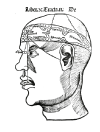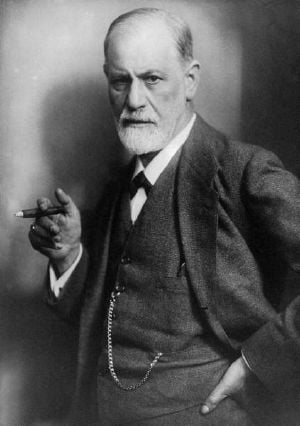| Psychology |
| History |
| Psychologists |
| Divisions |
|---|
| Abnormal |
| Applied |
| Biological |
| Clinical |
| Cognitive |
| Comparative |
| Developmental |
| Differential |
| Industrial |
| Parapsychology |
| Personality |
| Positive |
| Religion |
| Social |
| Approaches |
| Behaviorism |
| Depth |
| Experimental |
| Gestalt |
| Humanistic |
| Information processing |
Abnormal psychology is the field devoted to the study of causes of mental dysfunction (mental illness, psychopathology, maladjustment, emotional disturbance). Abnormal behavior expressed because of psychological dysfunction can have features of deviance (depending on the culture), distress, and possible injury to self or others. In fact, through the long history of humankind numerous types of dysfunction have manifested themselves. Abnormal psychology studies the causes and possible treatments of these dysfunctions.
The primary research in this field has been done with Western perspectives and research methods. Although a spiritual understanding of mental illness was embraced in ancient Western civilizations and in Eastern culture, it has been largely dismissed by the scientific community and by the majority of psychologists in more modern times.
In the twentieth century, two opposing perspectives on the etiology of mental disorders developed—somatogenic (physical origins) and psychogenic (psychological origins). Both produced significant research and treatment options. To truly understand the problems that beset humankind a complete approach including all aspects of human nature, including the spiritual, is needed. The field is beginning to expand to a worldwide level, broadening the scope of interpretation of causes of mental disorders to embrace Eastern (spiritual) perspectives as well.
Introduction
Abnormal psychology is the scientific study of abnormal behavior in order to describe, predict, explain, and change abnormal patterns of functioning. It studies the nature of psychopathology, its causes, and its treatments. Of course, the definition of what constitutes "abnormal" has varied across time and across cultures. Individuals also vary in what they regard as "normal" or "abnormal" behavior, or merely idiosyncratic.
In general, abnormal psychology can be described as an area of psychology that studies people who are consistently unable to adapt and function effectively in a variety of conditions. The four main contributing factors to how well an individual is able to adapt include their genetic makeup, physical condition, learning and reasoning, and socialization.
History
Many early societies attributed abnormal behavior to the influence of evil spirits.
Skulls have been found from as long ago as the Stone Age (half a million years ago) with areas removed by a method of surgery that involved making circular holes in the skulls with stone tools. It has been suggested that the purpose for such surgery was to release evil spirits, assumed to be causing mental problems in the patient.[1] Exorcism by priests and shamans has also been used in attempts to drive out invading spirits. Ironically, William James, the father of the American tradition in psychology, tried to incorporate a spiritual aspect to psychology that was replaced by the science of behaviorism in the next century.
During the Greek and Roman period, 500 B.C.E. to 500 C.E., some symptoms of mental disorders were classified into terms such as melancholia, dementia, hysteria, and hallucinations. They were generally assumed to be the result of some physical problem within the individual. Hippocrates (460 – 377 B.C.E.), considered to be the father of medicine, referred to brain pathologies as "humors" caused by yellow bile, black bile, blood, or phlegm. Plato (427 -347 B.C.E.) and Aristotle (384 – 322 B.C.E.) also believed that mental disturbances were generated from within the individual not from the influence of outside forces.
In the Middle Ages in Europe, 500 – 1350 C.E., the presence of Christian priests expanded across Europe. Deviant behavior or psychological dysfunction was viewed as created by the conflict between good and evil, God or Satan. Cruel methods of ridding the afflicted person of the devil’s influence were varied and often resulted in death or permanent disabilities. Hospitals to care for the mentally ill began to emerge at the end of the period.
The Renaissance period was a time when science flourished. The German physician, Johann Weyer (1515 – 1588 C.E.), was the first doctor to specialize in mental illness, defending those accused of witchcraft as suffering from some mental disturbance; he is consider to be the founder of modern psychopathology.[2] Some progress was made in England and Belgium to care for the sick but this deteriorated by the mid-sixteenth century when asylums began to replace hospitals. The first asylum was founded in Spain. In London, 1547, Henry VIII opened Bethelehem Hospital (pronounced Bedlam by the locals), resulting in the word "Bedlam" being used for lunatic asylums in general, and later for a scene of uproar and confusion.
At the time of the French Revolution, Philippe Pinet (1745 - 1826), became the chief physician at La Bicetre asylum in Paris. He believed the patients were sick people in need of kindness and care. The English Quaker, William Tuke (1773 – 1813), started similar reforms in the United States. Dorothea Dix (1802 – 1887) further championed the cause of human public care and took it to the level of political reform. She personally helped to establish 32 state hospitals.
However, it appears that every time a wave of improved treatment emerged it was followed by a period of decline, usually due to over capacity and lack of funding. “By the early years of the twentieth century, the moral treatment movement had ground to a halt in the United States and Europe.”[3]
In the early twentieth century, two opposing perspectives emerged: somatogenic and psychogenic. The former held that abnormal behavior had physical origins and the latter held that the causes of such were psychological. Biological science found causes for illnesses such as syphilis. The study of hypnotism launched the psychological origin (psychogenic) perspective. Franz Mesmer (1734 – 1815) introduced the treatment of hysteria with hypnotherapy, but this method called "mesmerism" was not well regarded by doctors of his day. Hypnosis was not seriously studied until the late 1800s in Vienna. It attracted Sigmund Freud (1856 – 1939) who later founded psychoanalysis.[4]
Psychopathology as the study of mental illness
Many different professions may be involved in studying mental illness or distress. Most notably, psychiatrists and clinical psychologists are particularly interested in this area and may either be involved in clinical treatment of mental illness, or research into the origin, development, and manifestations of such states, or often, both. More widely, many different specialties may be involved in the study of psychopathology. For example, a neuroscientist may focus on brain changes related to mental illness. Therefore, someone who is referred to as a psychopathologist may be one of any number of professions who have specialized in studying this area.
Psychiatrists in particular are interested in descriptive psychopathology, which has the aim of describing the symptoms and syndromes of mental illness. This is both for the diagnosis of individual patients (to see whether the patient's experience fits any pre-existing classification), or for the creation of diagnostic systems (such as the Diagnostic and Statistical Manual of Mental Disorders) which define exactly which signs and symptoms should make up a diagnosis, and how experiences and behaviors should be grouped in particular diagnoses (such as clinical depression or schizophrenia).
There are many models of abnormality that have been developed by those involved in attempting to treat those suffering various disorders.
The biological model
This perspective is adopted from a medical approach and typically regards a malfunctioning brain as the cause of abnormal behavior. Many factors are considered to be potential causes of biological dysfunction, ranging from head injury to poor nutrition. Genetics, evolution, and viral infection are areas that have received a great deal of attention. Treatments by biological practitioners utilize psychotropic medications, electroconvulsive therapy (ECT), and neurosurgery.
The psychodynamic model
The psychodynamic theory regards human behavior to be determined by underlying psychological influences that usually are unconscious. These influences (also called forces) are dynamic in that the relationship between them gives rise to behavior. Abnormal symptoms are created when conflicts arise in this relationship. This theory postulates that all behavior is determined by childhood events and past experience. Sigmund Freud (1856 – 1939) and Josef Brener (1842 – 1925) conducted experiments with hypnosis which put Freud on the path of formulating this theory. He contended that a person could become fixated or stuck at a stage where trauma occurred (usually childhood). Treatment then consists of psychoanalysis, which involves bringing into conscious awareness the traumatic childhood conflicts that have been repressed, and thus making them amenable to resolution.
The behavioral model
The behavioral model originated in laboratories experimenting with learning, where the understanding of conditioning arose. In operant conditioning, for example, human beings and animals learn to behave a certain way based on the rewards that they receive for certain responses. In classical conditioning, discovered by Ivan Pavlov (1849 – 1946) while experimenting with dogs, events occurring closely together in time whether positive or negative will be generalized and create the same response for either event at a later time. If one event produced happiness, the other event (even if it was negative) can be remembered as positive. The behavioral model of psychopathology suggests that abnormal responses, particularly phobias, were formed through a conditioning process, and also can be treated through new learning—a process known as behavior therapy.
The cognitive model

Albert Ellis (1962) and Aaron Beck (1967) developed the cognitive model in the early 1960s. They proposed that cognitive processes are at the center of behavior, thought, and emotions. To understand abnormal behavior required the clinician to ask their client questions about their attitudes and assumptions.[5]
Abnormal functioning according to cognitive theorists is explained by realizing that everyone creates their view of the world that comprises their reality. If the view created by an individual is flawed then unhealthy thoughts create dysfunctional behavior. Poorly adapted personal world views are the result of assumptions that are inaccurate. This leads to attitudes that are negative. Illogical thinking processes also are a source of destructive thinking patterns. One of these manifests as over-generalization which draws a broad negative conclusion following a minor event.
Treatment in this approach involves therapy sessions which work to change a client's self-defeating beliefs and behaviors by demonstrating their irrationality and rigidity. It is believed that through rational analysis, people can understand their errors in light of the core irrational beliefs and then construct a more rational way of conceptualizing themselves, their world, and the events in their lives.
The humanistic–existential model

Humanists and existential theorists ate grouped together in the humanistic-existential model because of their focus on the broader dimensions of human existence. However, there are differences between them. Humanistic psychologists maintain that human beings are naturally born with positive tendencies such as cooperation. The goal of people is to fulfill their potential for goodness and growth called self-actualization. Carl Rogers (1902 – 1987) is often considered the pioneer of the humanistic framework. He developed a warm approach to his work called client-centered therapy which focuses on supporting the person's achievement of their potential and their life goals.
Existentialists believe that from birth, each person has total freedom to face existence and find meaning or avoid taking responsibility. The existential view derived from nineteenth-century European existential philosophers.
The sociocultural model
The sociocultural approach holds that abnormal behavior is caused by the role that society and culture play in an individual’s life. It considers societal norms, roles in the social environment, cultural background, family, and views of others. Sociocultural theorists focus on societal labels and rules, social networks, family structure, communication, cultural influences, and religious beliefs.[6]
The biopsychosocial model
Beyond understanding how the genetic, chemical, electrical, and molecular dimensions in brain function, many practitioners have taken on a more eclectic approach to treating their clients. In this approach abnormal behavior is studied from the viewpoint of the psychological, biological, and societal influences on behavior.
Classification systems
The two major classification systems for psychological disorders are the Diagnostic and Statistical Manual (DSM) and the International Classification of Diseases (ICD). In earlier versions their systems were markedly different. Though recent editions of the DSM and ICD have become more similar due to collaborative agreements, each one contains information absent from the other.
Diagnostic and Statistical Manual
In North America, the "bible" of abnormal psychology and psychiatry is the Diagnostic and Statistical Manual (DSM) of the American Psychiatric Association.[7] It is the main book for the diagnosis and treatment of mental disorders in the United States and Australia, while in other countries it may be used in conjunction with other documents.
The 5th edition of the DSM, the DSM-5, was released in 2013,[8] and the latest version, the 5th Edition Text Revision: DSM-5-TR, was released in 2022.[9] The DSM-5 contains extensively revised diagnoses compared to DSM-IV and, in some cases, broadens diagnostic definitions while narrowing definitions in other cases.[85] The DSM-5 is the first major edition of the manual in 20 years
The DSM lists a set of disorders and provides detailed descriptions on what constitutes a disorder such as Depressive Disorders (including Major depressive disorder) or Anxiety Disorders (including Obsessive–compulsive disorder and Post-traumatic stress disorder). It also gives general descriptions of how frequent the disorder occurs in the general population, whether it is more common in males or females and other such facts.
The disorders are categorized as follows:[10]
- Neurodevelopmental Disorders
- Schizophrenia Spectrum and Other Psychotic Disorders
- Bipolar and Related Disorders
- Depressive Disorders
- Anxiety Disorders
- Elimination Disorders
- Other Mental Disorders and Additional Codes
- Obsessive-Compulsive and Related Disorders
- Trauma- and Stressor-Related Disorders
- Dissociative Disorders
- Somatic Symptom and Related Disorders
- Feeding and Eating Disorders
- Sleep-Wake Disorders
- Sexual Dysfunctions
- Gender Dysphoria
- Disruptive, Impulse-Control, and Conduct Disorders
- Substance-Related and Addictive Disorders
- Neurocognitive Disorders
- Personality Disorders
- Paraphilic Disorder
- Medication-Induced Movement Disorders and Other Adverse Effects of Medication
- Other Conditions That May Be a Focus of Clinical Attention
ICD-11
The major international nosologic system for the classification of mental disorders can be found in the most recent version of the International Classification of Diseases, 11th revision (ICD-11) published in 2022 by the World Health Organization.[11] Even though the DSM is used primarily in North America, for billing purposes, the ICD-11 is the required diagnostic code set.[7]
The ICD was designed as a health care classification system, providing a system of diagnostic codes for classifying diseases, including nuanced classifications of a wide variety of signs, symptoms, abnormal findings, complaints, social circumstances, and external causes of injury or disease. Thus, it includes all types of disease and disorder, physical and mental. The codes for "Mental, behavioural or neurodevelopmental disorders" are found in Chapter 6, and include the following caegories:[12]
- Neurodevelopmental disorders
- Schizophrenia or other primary psychotic disorders
- Catatonia
- Mood disorders
- Anxiety or fear-related disorders
- Obsessive-compulsive or related disorders
- Disorders specifically associated with stress
- Dissociative disorders
- Feeding or eating disorders
- Elimination disorders
- Disorders of bodily distress or bodily experience
- Disorders due to substance use or addictive behaviours
- Impulse control disorders
- Disruptive behaviour or dissocial disorders
- Personality disorders and related traits
- Paraphilic disorders
- Factitious disorders
- Neurocognitive disorders
- Mental or behavioural disorders associated with pregnancy, childbirth or the puerperium
Notes
- ↑ Ronald J. Comer, Abnormal Psychology (NY: Worth Publishing, 2006, ISBN 0716769069).
- ↑ Comer, 10.
- ↑ Comer, 15.
- ↑ Comer, 16.
- ↑ Comer, 64.
- ↑ Comer, 71.
- ↑ 7.0 7.1 The Diagnostic and Statistical Manual of Mental Health Disorders American Psychological Association. Retrieved December 2, 2025.
- ↑ American Psychiatric Association, Diagnostic and Statistical Manual of Mental Disorders, 5th Edition: DSM-5 (American Psychiatric Publishing, 2013, ISBN 978-0890425541)
- ↑ American Psychiatric Association, Diagnostic and Statistical Manual of Mental Disorders, 5th Edition Text Revision: DSM-5-TR (American Psychiatric Publishing, 2022, ISBN 0890425760).
- ↑ The Organization of DSM-5-TR American Psychiatric Association. Retrieved January 25, 2024.
- ↑ International Classification of Diseases 11th Revision (ICD-11) World Health Organization. Retrieved January 25, 2024.
- ↑ 06 Mental, behavioural or neurodevelopmental disorders World Health Organization. Retrieved January 25, 2024.
ReferencesISBN links support NWE through referral fees
- American Psychiatric Association. Diagnostic and Statistical Manual of Mental Disorders DSM-IV, 4th ed. Washington, DC: American Psychiatric Association, 1994. ISBN 0890420610
- American Psychiatric Association. Diagnostic and Statistical Manual of Mental Disorders DSM-IV-TR, 4th ed. (Text Revision.) Washington, DC: American Psychiatric Association, 2000. ISBN 9780890420256
- American Psychiatric Association. Diagnostic and Statistical Manual of Mental Disorders, 5th Edition: DSM-5. American Psychiatric Publishing, 2013. ISBN 978-0890425541
- American Psychiatric Association. Diagnostic and Statistical Manual of Mental Disorders, 5th Edition Text Revision: DSM-5-TR. American Psychiatric Publishing, 2022. ISBN 0890425760
- Capps, Donald. The Child's Song: The Religious Abuse of Children. Louisville, KY: Westminster Knox Press, 1995. ISBN 066425554X
- Comer, Ronald J. Abnormal Psychology, 6th ed. New York, NY: Worth Publishers, 2006. ISBN 0716769069
- Miller, Alice. For Your Own Good. Farrar, Straus, Giroux, 1990. ISBN 978-0374522698
- Miller, Alice. Though Shalt Not Be Aware. New York, NY: New American Library, 1986. ISBN 978-0374525439
- Sims, Andrew. Symptoms in the Mind: An Introduction to Descriptive Psychopathology, 3rd ed. Elsevier, 2002. ISBN 0702026271
External links
All links retrieved December 2, 2025.
- How Psychologists Define and Study Abnormal Psychology Simply Psychology
- A Short History of Abnormal Psychology King University
- How Psychologists Define and Study Abnormal Psychology Verywell Mind
- The World of Abnormal Psychology Annenberg Learner
- Abnormal Psychology Psychology Info
Credits
New World Encyclopedia writers and editors rewrote and completed the Wikipedia article in accordance with New World Encyclopedia standards. This article abides by terms of the Creative Commons CC-by-sa 3.0 License (CC-by-sa), which may be used and disseminated with proper attribution. Credit is due under the terms of this license that can reference both the New World Encyclopedia contributors and the selfless volunteer contributors of the Wikimedia Foundation. To cite this article click here for a list of acceptable citing formats.The history of earlier contributions by wikipedians is accessible to researchers here:
The history of this article since it was imported to New World Encyclopedia:
Note: Some restrictions may apply to use of individual images which are separately licensed.



